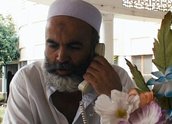


Son of a Lion (2007)
Synopsis
In a town in Pakistan’s mountainous North-West Frontier Province, an 11-year-old Pashtun boy, Niaz Afridi (Niaz Khan Shinwari), makes illegal copies of guns in his father’s arms manufacturing workshop. His widower father, Sher (Sher Alam Miskeen Ustad), also gives him regular shooting lessons.
Niaz, who is illiterate, has ambitions to go to school to learn how to read and write. He is encouraged by Agha Jaan (Agha Jaan), an artist and refugee living in a camp just outside of town, and by his uncle, Baktiyar (Baktiyar Ahmed Afridi), a well-off businessman, whom he visits while in the city of Peshawar to see a dentist. The uncle tries to enrol Niaz in a Peshawar school but the boy’s father vehemently refuses to give permission and tells him to mind his own business.
Through a series of dramatic events, Niaz shows his determination to become a student and to reject the culture of violence for which his father is preparing him.
Curator’s notes
The story behind this brave independent film is as fascinating as the film itself. Benjamin Gilmour, a Sydney paramedic, developed and shot it with a cast of non-professionals and a portable digital camera in the remote tribal region of North-West Frontier Pakistan near the Afghanistan border.
Gilmour first came across the involvement of children in illegal arms manufacture in Darra Adam Khel on a holiday trek in August 2001. After the terrorist attacks on the United States on 11 September 2001, he decided to return to make a film to express his feelings about events in the world. Revisiting Darra Adam Khel in 2004, he disguised himself as a Pashtun man by growing a beard and wearing long robes. This was to avoid being detained by the Pakistani authorities (Westerners are not allowed into the area) while he worked on winning the trust of tribal elders. After several months he revealed his plan to make a fictional film closely based on the lives of North-West Frontier people. Once he had earned the support of a respected landowner, Hayat Khan Shinwari (who has an executive producer credit and whose relatives play three roles), it was easier to persuade others in the region to cooperate.
Gilmour says the Pashtuns knowingly risked their lives working on the film (locals who collaborated with Westerners were known to vanish). They were prepared to help because of their desire to tell their story and their frustration at being viewed by the outside world as extremists. Gilmour returned in 2006, once more disguised, to discreetly film his non-professional cast in their homes, as well as in compounds, an arms factory, on the streets and in open spaces.
Gilmour developed the script with the Pashtuns, loosely basing it on stories they told him. He and producer Carolyn Johnson say the film’s estimated initial production cost was $20,000. The Australian Film Commission provided post-production funding of $420,000.
The film’s humanistic values, naturalistic filming style and focus on a child’s story have similarities with the style and content of much contemporary Iranian cinema (such as Children of Heaven, 1997, and The White Balloon, 1995). Gilmour successfully conveys the way of life and social attitudes of a remote tribal region that is hard for Westerners to visit but, thanks to the war in neighbouring Afghanistan, often in the news.
Son of a Lion resonates beyond its topicality. Niaz’s struggle for an education and a life free of the old violent ways is emblematic of the fight of children everywhere to develop their individuality in spite of opposing pressures. Above all it represents the universal struggle for freedom and independence. Key themes – education versus work, the life of the mind versus the culture of aggression and guns, new ways versus tradition, city sophistication versus provinciality, the West versus the Islamic world – are given lucid expression, aided by Gilmour’s strong narrative instincts and the cast’s unaffected performances. The first names of his characters are those of the actors playing the roles, a technique encouraging the cast members to closely identify with their parts. The film is also helped by Gilmour’s sure sense of visual framing and Amanda Brown’s resonant music score.
- Overview
- Curator’s notes
- Video 3 clips

- Principal credits
- Find a copy
- Make a comment
- Map
- Add your review



